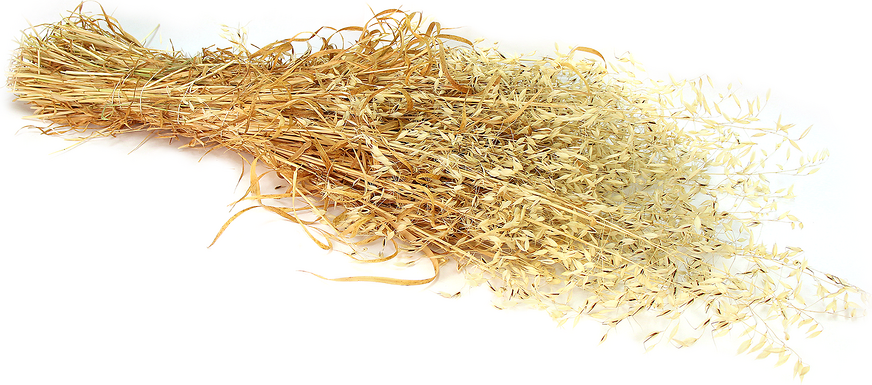


Wild Oats
Estimated Inventory, bunch : 0
Description/Taste
Wild oats are a resilient grass that flourishes in a variety of settings, from farmland to wild areas. These plants have tall stems that can reach up to 1.3 meters, with leaves that start rolled up and unroll in a counter-clockwise direction as they open. Attached to these leaves are lance-shaped glumes that protect and encase the slender, slightly tapered seeds. The plant is mostly bright green, contrasting with the straw-colored husks that encase the seeds, which themselves vary in color from light beige to brown. The ribbed texture and small hairs that grow on the leaves of the Wild oat plant give it a slightly rough texture. The stems and glumes of the plant are rough and rigid, giving it the resilience needed to survive in the wild. The seeds are hard, smooth, and somewhat glossy, adding to the plant’s robust nature. While Wild oats aren't particularly fragrant, they may emit a faint, grassy smell when crushed. Ground up, the plant has a flour-like taste with creamy and nutty undertones.
Seasons/Availability
Wild oats can be foraged from late summer through October.
Current Facts
Wild oat, botanically known as Avena fatua from the Poaceae family, is commonly referred to as Wheat oats, Oatgrass, Flaxgrass, Poor oats, and Black oats. Though Wild oat is frequently found in commercial wheat and barley fields and is often used for hay or animal grazing, it's not as commercially significant as domestic oat (Avena sativa). While the two plants look similar in the wild, they serve different purposes. Wild oat is considered a weed due to its invasive nature and smaller, less palatable seeds, whereas Domestic oat has been selectively bred for larger, tastier, and more nutritious seeds used in products like oatmeal and flour. During vegetative growth, Wild oat is indistinguishable from domestic oats but can be identified by its typically darker seed with a hairy husk base, unlike the smooth, hairless husk of domestic oats. Although considered an invasive species, Wild oat can be foraged as a valuable crop in its own right as it can be used for biomass, mulch, paper-making, thatching, and even some culinary applications.
Nutritional Value
Wild oats are packed with beta-glucans, a type of soluble fiber that can help lower cholesterol, control blood sugar, and boost immune function. They're also rich in B vitamins, which support a healthy nervous system, aid in digestion, and contribute to skin and eye health. Wild oats are a good source of magnesium and iron, essential nutrients that keep your energy levels up, muscles functioning, and oxygen flowing. The phosphorus in Wild oats may help with brain and nerve tissue development. Eating oats might also help improve sleep due to their calming effects on the nervous system. Medicinally, Wild oats can be used as a nerve tonic and are useful for rejuvenation, particularly after illnesses with fever, by restoring energy and calming the nervous system. Oatmeal made from Wild oats can be used in poultices to soothe itches and ulcers, or boiled in vinegar for a topical application that helps remove skin spots, although it might worsen acne. Those with hay fever or asthma might need to avoid Wild oats due to potential allergic reactions.
Applications
The primary edible part of the Wild oats plant is their seeds, which can be harvested, processed, and used similarly to Domestic oat seeds. Common uses include making oatmeal or grinding the seeds into flour for baking breads, biscuits, muffins, and cookies. The seeds can also be sprouted for salads, blended into smoothies, used to make granola bars, roasted as a coffee substitute, or cooked in stews, stocks, tomato sauces, pestos, gravies, and dips. Wild oat seeds can be soaked, blended, and strained to create an oat "milk” that adds a smooth texture and nutty flavor to whipped creams, yogurts, and other creamy dishes. Wild oats pair well with apples, bananas, berries, pears, almonds, walnuts, pecans, chia seeds, and chocolate. They can be mixed with spices such as cinnamon, nutmeg, ginger, and cardamom. To prepare the seeds, hand sort them to clear out any debris and husks, then wash and dry them. Once dry, these seeds can be stored for several years.
Ethnic/Cultural Info
Wild oats were likely introduced to North America by Spanish missionaries during European colonization and exploration. Since then, Native American tribes have gathered Wild oat seeds for hundreds of years, collecting and lightly crushing them to loosen the chaff, which was then winnowed out and ground into meal. The Kumeyaay tribe used the seeds to make pinole, a roasted ground maize that can be mixed with cocoa, agave, cinnamon, chia seeds, vanilla, and other spices to create a beverage called pinolillo. This drink, now popular in Nicaragua, Costa Rica, and Honduras, is consumed hot like cocoa or cold like iced coffee or horchata. Wild oats are still used as a breakfast food by some Cahuilla, who believe it contributes to high energy.
Geography/History
Wild oat plants are native to Europe and Central and Southwest Asia and now grow in temperate areas worldwide. Preferring dry, sunny environments, they do not grow well in the shade but can tolerate drought. Wild oats most often thrive in grasslands, crop fields, orchards, vineyards, gardens, roadsides, and other disturbed sites. Introduced to North America by early European settlers in the late 15th and early 16th centuries, Wild oats have spread to various parts of the world, including Australia, New Zealand, Africa, and South America. Because Wild oat seeds disperse easily, the plant has become a noxious weed in many regions. Despite this, its widespread availability makes Wild oats an easily forageable item in fields and gardens.




